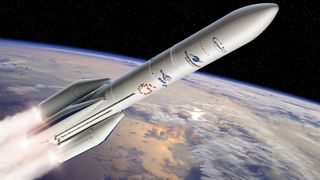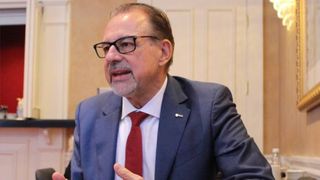
Mars exploration, new rockets and more: Interview with ESA chief Josef Aschbacher
"It's magic to get it all together, and it's a lot of work."

Shaping an ambitious and steady space agenda for Europe requires not only diplomatic aplomb but also a firm grounding in science and engineering. Indeed, those attributes are must-haves in working with the 22 member states of the European Space Agency (ESA).
Josef Aschbacher is ESA's director general, taking on that role in March 2021. He is responsible for evolving Europe's space infrastructure, from rockets and spacecraft performing Earth observation, navigation, and telecommunication duties to robotic planetary exploration, as well as the ESA astronauts serving aboard the International Space Station.
"It's magic to get it all together, and it's a lot of work," Aschbacher said. The challenges are many, he added. For example, he's working to ensure that Europe has independent access to space — a critical need for the member states.
Space.com caught up with Aschbacher this month at the Space Foundation's 39th Space Symposium in Colorado Springs, Colorado to discuss what's ahead for ESA. The following interview has been edited for length.
Related: European Space Agency: Facts & information

Space.com: In July 2023, the venerable Ariane 5 roared skyward and attained retirement status. But that launch also signaled what you saw as Europe entering a launch crisis. How are you dealing with that predicament?
Josef Aschbacher: We had quite a few challenges. Industry took the lead on Ariane 6 with ESA as the system architect, the customer. When I became ESA director general, my first act was to identify, Where do we stand? The news was not good. I had to reestablish teams to work the technical aspects and reconfigure the team spirit among the partners, between CNES, the French space agency, ArianeGroup, Arianespace and ESA. Hundreds of people were involved in various technical teams and sub-groups. We are systematically going through the milestones.
Get the Space.com Newsletter
Breaking space news, the latest updates on rocket launches, skywatching events and more!
Space.com: And the result?
Aschbacher: We had to get together and work as a team. Credit to the task force and tiger teams that are testing and resolving problems. I was spending, literally, 60-70% of my time on launchers — so a huge amount of time getting this right. We are on a good path now, with Ariane 6 now scheduled between mid-June to end of July.
Space.com: In the big ESA picture, what is of concern to you?
Aschbacher: I think what we need to do — and it's a huge challenge — is to ensure that our governance is working well. That is, the role of ESA, the European Union, our member states, that we are not too fragmented, that we are aligned and putting our assets well together. On paper, it should be easy. In practice, it sometimes is a bit more complicated. But I am very committed to make it work.
Space.com: Next year, you're headed for the ESA Council Ministerial Meeting, setting the policy guidelines for the European space program. How's it looking at the moment?
Aschbacher: There are lots of budget issues everywhere. In Europe we're doing OK, but it will be tough. For the ministerial next November, we are already starting to prepare the first elements. With our 22 member states, some states can, or perhaps they do not want to, subscribe to projects. It's quite diverse, and we do not know how much the ministers will commit to.
My job is to negotiate and prepare for a portfolio of, say, 30 programs. So it's a year and a half of preparation. It's always high tension. Very intensive activity. At the beginning of the day and a half of a ministerial, I do not know how the day will end. I have not seen any other organization worldwide which has such a funding scheme.
Related: NASA gets $25.4 billion in White House's 2025 budget request
Space.com: One area that haunts all is the continuing growth, spread and daunting problem of orbital debris. ESA has moved forward on a "Zero Debris Charter." Why, and what is behind that initiative?
Aschbacher: We have been working on the debris issue for numbers of years. We have an active space safety office in the European Space Operations Center [ESOC] in Germany. We are active and have established a Zero Debris Charter initiative. Those that sign up have to commit themselves that, at the end of life of their satellite, they will take that spacecraft out of orbit.
It is like going into a national park. You bring in your lunch box, and after you have eaten, take the lunch box and rubbish out of the national park to make sure that the park is kept clean. And this is what we want do with orbits around the Earth.
A satellite doing its business for 10 years, at the end of its life should be taken out of orbit. The ones who sign up should commit that they are doing that.
Space.com: And for ESA, what do you do?
Aschbacher: I've done this for ESA, instructing my engineers that our satellites that are being built now have to adhere to this principle. Use an active de-orbiting mechanism, have the fuel to get out of orbit. They need to make sure that when the satellite breaks up, it breaks up in small enough pieces that they burn up in the atmosphere. Nothing falls down on the Earth's surface. So this is now in place in ESA.
But of course, I would like others to join as well. We've put it up for signature and have two signature events planned this year, one in May and one in June. One for European partners, one for international partners.
So far we have about 100 intentions for signatures already registered — a mix of private companies and organizations, space agencies, public entities.
Space.com: Ink is cheap. Who keeps an eye on them?
Aschbacher: The charter is a declaration of intent, but it's not legally binding. I'm not a regulatory body; I am a space agency. I want to create the awareness, raise the point to the politicians. I want to be a champion of sustainability in space and hope that others follow by recognizing the importance of this issue.
Space.com: Has NASA signed the charter?
Aschbacher: I've got a meeting here, and I'll ask the question.
Space.com: There has been a recent event of an International Space Station battery-carrying pallet that was purposely tossed off to re-enter the Earth's atmosphere. Subsequently, it appears that a piece of that object hit a home in Florida. Who is responsible in that incident?
Aschbacher: There are some rules based on international law, the launching state responsibility, the operator responsibility. I would say there's a bit of a weak legal regime that exists. I think it would be difficult to enforce in court. But there is some pre-understanding of who would be in charge, or a first point to go to in case something happens. It's not for me to comment. I'm not a lawyer. This is really for lawyers to look into. There will be a discussion.
Related: Kessler Syndrome and the space debris problem

Space.com: Branching out into deep space exploration: How's ESA's ExoMars endeavor moving forward?
Aschbacher: ExoMars started around 2010-2011, with NASA originally a partner. But budget issues had NASA drop out. So then, in working with Russia, it moved forward for about 10 years. With war in Ukraine and the sanctions that our member states imposed on Russia, I could not finish the program. And this is something quite drastic. The ExoMars rover was finished and ready for launch in September 2022. The war started in February 2022, so I stopped and terminated the cooperation with Russia.
We had to completely reconfigure the mostly European mission, now with a very significant but smaller contribution of NASA. They provide three elements: the radio isotope heater unit which Europe does not have, the braking engines needed for landing, and the launcher. NASA has been supporting ExoMars, and we appreciate that strong cooperation. We plan to launch in 2028.
Space.com: How important is ExoMars in our study of the Red Planet?
Aschbacher: It will drill into the surface, which is quite unique. There's no chance to find life on the surface. You have to go down, and exobiologists are saying at least 1.5 meters [4.9 feet], and we go down 2 meters [6.6 feet]. Can you imagine how exciting this will be? Just imagine finding some microbes of life and to analyze whether there is DNA or no DNA. Would the DNA be similar to ours or not? Unimaginable — and we just don't know.
Join our Space Forums to keep talking space on the latest missions, night sky and more! And if you have a news tip, correction or comment, let us know at: community@space.com.

Leonard David is an award-winning space journalist who has been reporting on space activities for more than 50 years. Currently writing as Space.com's Space Insider Columnist among his other projects, Leonard has authored numerous books on space exploration, Mars missions and more, with his latest being "Moon Rush: The New Space Race" published in 2019 by National Geographic. He also wrote "Mars: Our Future on the Red Planet" released in 2016 by National Geographic. Leonard has served as a correspondent for SpaceNews, Scientific American and Aerospace America for the AIAA. He has received many awards, including the first Ordway Award for Sustained Excellence in Spaceflight History in 2015 at the AAS Wernher von Braun Memorial Symposium. You can find out Leonard's latest project at his website and on Twitter.
